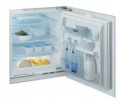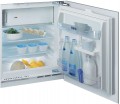Total capacity
The total volume of a refrigerator is the sum of the volumes of all its compartments, which can vary in specific capacity between different models. It's important to consider this when choosing a refrigerator.
A larger volume for a refrigerator can be beneficial for accommodating more food, but it can also increase the price and size of the appliance. This is especially important to consider if you plan to build the refrigerator into a specific space.
Number of chambers
The number of separate chambers with different functionality provided in the design of the refrigerator. Modern refrigerators can be equipped with a refrigerator, freezer, wine chamber, “fresh zones” for fruits and vegetables, etc. The total number of cameras can be up to five.
Single -chamber Single-chamber refrigerators are inexpensive and have a simple design, as they consist of only one chamber, which serves as the refrigerating chamber (refer to "Volume of the refrigerating chamber" for more information).
Two-chamber refrigerators usually consist of a refrigerator and a freezer. Refrigerators can have a freezer that is accessible through the refrigerator compartment or through a separate door. The former is more compact and affordable, but less convenient as it requires opening two doors to access the freezer and defrosting the entire refrigerator.
Three-chamber refrigerators contain a freshness zone, also known as the zero chamber, in addition to the refrigerator and freezer compartments (for more details, see "Freshness zone"). This zone is designed for the long-term storage of fresh products and can increase the price of the refrigerator.
Refrigerators with
four or more chambers can have two separate freshness zones (“dry” and “wet”), a wine chamber (see "Wine chamber").
More chambers in a refrigerat
...or provide greater storage options for different types of products, but this also increases the price and size of the appliance. The layout of the refrigerator is also important, especially in terms of the location of the freezer.Refrigerator capacity
The refrigerating compartment is designed for storage of products that do not require freezing, i.e. cooling down to temperatures below zero. The temperature range inside varies from +2 to +10. In almost all modern refrigerators, it is this compartment that has the largest volume.
To ensure optimal performance and food quality, it's important to choose the appropriate volume for the refrigerating compartment based on your actual food storage needs and how often you replenish your supplies. Overfilling the compartment can have a negative impact on both the refrigerator's performance and the quality of the stored food.
For singles or couples, a refrigerating compartment of up to 200 liters is enough, while families or those who stock up on food should opt for models with up to 400 liters. Vertical refrigerators with separate freezer access are suitable for those who need moderate storage space, while side-by-side refrigerators with their typically larger volumes are a good option for those who require even more space and have ample free space.
Number of shelves
The amount of shelves in a refrigerator determines the division of space within the refrigeration compartment. Larger refrigeration compartments generally have more shelves, but there are also various configurations available even within the same volume (
3 shelves,
4 shelves,
5 shelves and more). It is worth considering that they are mostly removable, which allows you to adjust the height of the shelf. And if necessary, you can buy more.
Freezer location
The location of the freezer in the refrigerator.
—
Top. One of the standard options for vertical refrigerators. It is consideredless practical than the bottom location. In such models, the main compartment is situated quite low, requiring users to bend over to access it. However, for individuals who are shorter in height, this feature may actually be advantageous rather than a drawback.
It's worth mentioning that the top location is commonly found in compact refrigerators where the freezer doesn't have its own external door, and one needs to open the main compartment before accessing it.
—
Bottom. The lower position is a classic and widely used configuration for vertical refrigerators, as well as in side-by-side models to a lesser extent. The main advantage of this setup is that the freezer compartment is accessed less frequently than the main compartment, and placing it at the bottom reduces the need for users to frequently bend over to reach it.
—
Side. Side-by-side refrigerators typically have the freezer located on one side of the unit, with the other side dedicated to the main compartment. The freezer may take up the entire half of the refrigerator, or be combined with other compartments, such as a freshness zone or wine storage. These models are often larger in capacity and size.
—
Absence.
...The absence of a freezer is a common feature in some refrigerators, especially in small and affordable single-compartment models. However, it is not limited to compact designs, as larger refrigerators with a volume of 300 liters or more may also be freezer-free. Additionally, some two-compartment models reserve the second compartment for a freshness zone instead of a freezer. Lastly, refrigerated display cases, which are used for commercial purposes, do not include freezers (see "Type").Freezer capacity
The primary function of the freezer is to store food in a state of deep freeze, which helps preserve perishable products such as meat, vegetables, fruits, etc. for extended periods of time. The necessary volume of the freezer depends on the planned amount of food to be stored and the length of time it will be stored. A larger freezer is particularly useful if you plan to store food for several months.
A compact freezer is relevant for short-term storage (for a day or two) or for seasonal devices (for example, in the village). It is best to ensure that the freezer is not overloaded and has enough space for proper circulation of air to maintain the desired temperature.
Autonomy time
Refrigerators with good thermal insulation can maintain low temperatures inside for a significant amount of time even if there is a power outage. This period of time is known as the "keep cold time," during which the refrigerator can preserve perishable food items. A longer keep cold time indicates better thermal insulation, making the refrigerator more suitable for areas where power outages are common.
Freeze capacity
The freezing capacity of a refrigerator refers to the amount of fresh food it can freeze from room temperature to the freezer temperature within a 24-hour period. For everyday use, a freezing capacity of up to 10 kg/day is sufficient, but if you frequently freeze large volumes of food, you should consider a more
powerful freezer.
Energy class
The energy class that the refrigerator corresponds to.
Energy consumption classes were originally designated with Latin letters from
A (the most efficient) to D (least efficient), but with technological advancements, more advanced classes such as "A+", "A++", etc. were introduced to indicate increasing levels of efficiency. The more pluses a device has, the more economical it is. This was necessary due to the correlation between energy consumption and decreasing efficiency.
For modern built-in refrigerators, the efficiency indicator at the level of class A can be called average,
A+ — not bad,
A++ — good,
A+++ — excellent. Energy consumption rates B and C are rare and mostly found in outdated or cheaper models. Achieving high efficiency requires design innovations, which results in higher device prices. However, these prices can be justified by the resulting reduction in electricity bills. It's worth noting that some built-in refrigerator models are available in different energy consumption classes, allowing customers to choose the best option for their budget and energy efficiency needs.

